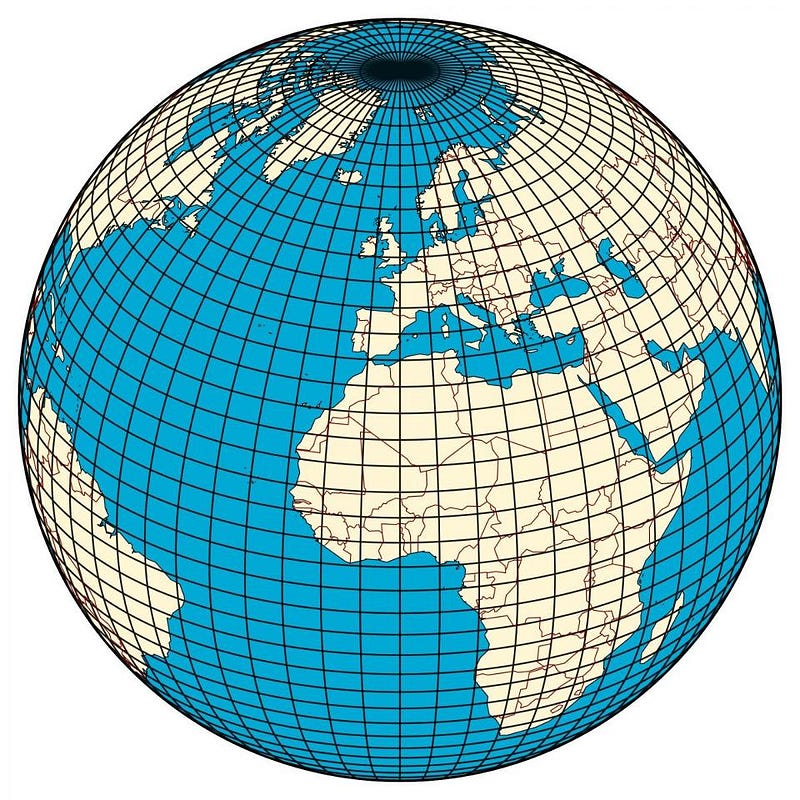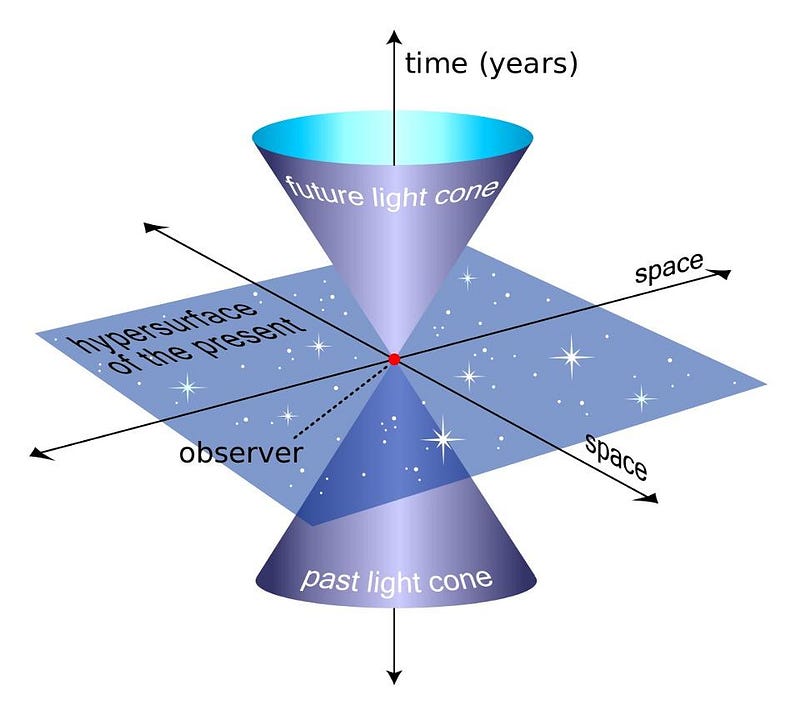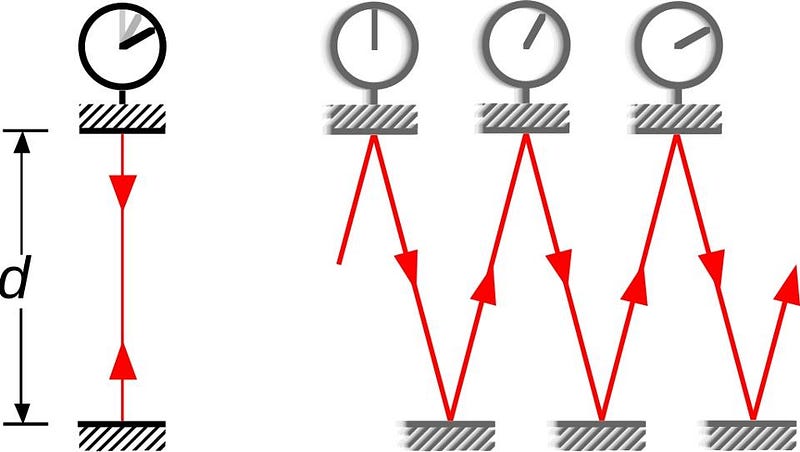
“It is old age, rather than death, that is to be contrasted with life. Old age is life’s parody, whereas death transforms life into a destiny: in a way it preserves it by giving it the absolute dimension. Death does away with time.” -Simone de Beauvoir
When we think about how we can move through the Universe, we immediately think of three different directions. Left-or-right, forwards-or-backwards, and upwards-or-downwards: the three independent directions of a Cartesian grid. All three of those count as dimensions, and specifically, as spatial dimensions. But we commonly talk about a fourth dimension of a very different type: time. But what makes time a dimension at all? That’s this week’s Ask Ethan question from Thomas Anderson, who wants to know:
I have always been a little perplexed about the continuum of 3+1 dimensional Space-time. Why is it always 3 [spatial] dimensions plus Time?
Let’s start by looking at the three dimensions of space you’re familiar with.
On the surface of a world like the Earth, two coordinates, like latitude and longitude, are sufficient to define a location. Image credit: Wikimedia Commons user Hellerick.
Here on the surface of the Earth, we normally only need two coordinates to pinpoint our location: latitude and longitude, or where you are along the north-south and east-west axes of Earth. If you’re willing to go underground or above the Earth’s surface, you need a third coordinate — altitude/depth, or where you are along the up-down axis — to describe your location. After all, someone at your exact two-dimensional, latitude-and-longitude location but in a tunnel beneath your feet or in a helicopter overhead isn’t truly at the same location as you. It takes three independent pieces of information to describe your location in space.

Your location in this Universe isn’t just described by spatial coordinates (where), but also by a time coordinate (when). Image credit: Pixabay user rmathews100.
But spacetime is even more complicated than space, and it’s easy to see why. The chair you’re sitting in right now can have its location described by those three coordinates: x, y and z. But it’s also occupied by you right now, as opposed to an hour ago, yesterday or ten years from now. In order to describe an event, knowing where it occurs isn’t enough; you also need to know when, which means you need to know the time coordinate, t. This played a big deal for the first time in relativity, when we were thinking about the issue of simultaneity. Start by thinking of two separate locations connected by a path, with two people walking from each location to the other one.

Two points connected by a 1-dimensional (linear) path. Image credit: Wikimedia Commons user Simeon87.
You can visualize their paths by putting two fingers, one from each hand, at the two starting locations and “walking” them towards their destinations. At some point, they’re going to need to pass by one another, meaning your two fingers are going to have to be in the same spot at the same time. In relativity, this is what’s known as a simultaneous event, and it can only occur when all the space components and all the time components of two different physical objects align.
This is supremely non-controversial, and explains why time needs to be considered as a dimension that we “move” through, the same as any of the spatial dimensions. But it was Einstein’s special theory of relativity that led his former professor, Hermann Minkowski, to devise a formulation that put the three space dimensions and the one time dimension together.

Whether flat or curved, moving through space has implications for moving through time as well. Image credit: Pixabay user Johnson Martin.
We all realize that to move through space requires motion through time; if you’re here, now, you cannot be somewhere else now as well, you can only get there later. In 1905, Einstein’s special relativity taught us that the speed of light is a universal speed limit, and that as you approach it you experience the strange phenomena of time dilation and length contraction. But perhaps the biggest breakthrough came in 1907, when Minkowski realized that Einstein’s relativity had an extraordinary implication: mathematically, time behaves exactly the same as space does, except with a factor of c, the speed of light in vacuum, and a factor of I, the imaginary number √(-1).

An example of a light cone, the three-dimensional surface of all possible light rays arriving at and departing from a point in spacetime. Image credit: Wikimedia Commons user MissMJ.
Putting all of these revelations together yielded a new picture of the Universe, particularly as respects how we move through it.
-
If you’re completely stationary, remaining in the same spatial location, you move through time at its maximal rate.
-
The faster you move through space, the slower you move through time, and the shorter the spatial distances in your direction-of-motion appear to be.
-
And if you were completely massless, you would move at the speed of light, where you would traverse your direction-of-motion instantaneously, and no time would pass for you.

A stationary observer sees time pass normally, but an observer moving rapidly through space will have their clock run slower relative to the stationary observer. Image credit: Michael Schmid of Wikimedia Commons.
From a physics point of view, the implications are astounding. It means that all massless particles are intrinsically stable, since no time can ever pass for them. It means that an unstable particle, like a muon created in the upper atmosphere, can reach the Earth’s surface, despite the fact that multiplying its lifetime (2.2 µs) by the speed of light yields a distance (660 meters) that’s far less than the distance it must travel. And it means that if you had a pair of identical twins and you left one on Earth while the other took a relativistic journey into space, the journeying twin would be much younger upon return, having experienced the passage of less time.

Mark and Scott Kelly at the Johnson Space Center, Houston Texas; one spent a year in space (and aged slightly less) while the other remained on the ground. Image credit: NASA.
As Minkowski said in 1908,
The views of space and time which I wish to lay before you have sprung from the soil of experimental physics, and therein lies their strength. They are radical. Henceforth, space by itself, and time by itself, are doomed to fade away into mere shadows, and only a kind of union of the two will preserve an independent reality.
Today, the formulation of spacetime is even more generic, and encompasses the curvature inherent to space itself, which is how special relativity got generalized. But the reason time is just as good a dimension as space is because we’re always moving through it, and the reason it’s sometimes written as a “1″ in “3+1″ (instead of just treated as another “1″ of the “4″) is because increasing your motion through space decreases your motion through time, and vice versa. (Mathematically, this is where the I comes in.)

Having your camera anticipate the motion of objects through time is just one practical application of the idea of time-as-a-dimension. The remarkable thing is that anyone, regardless of their motion through space relative to anyone else, will see these same rules, these same effects and these same consequences. If time weren’t a dimension in this exact way, the laws of relativity would be invalid, and there might yet be a valid concept such as absolute space. We need the dimensionality of time for physics to work the way it does, and yet our Universe provides for it oh so well. Be proud to give it a “+1” in all you do.
















